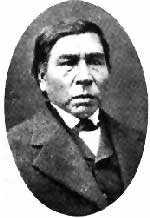Enmegahbowh

Enmegahbowh (ca. 1807 – June 12, 1902; from Enami'egaabaw, meaning "He that prays [for his people while] standing"; also known as John Johnson) was the first Native American to be ordained a priest in the Episcopal Church in the United States of America.
Life

Born around 1820, Enmegahbowh (pronounced En-meh-GAHboe),[1] was the only child of the chief of an Ojibwe Band on Rice Lake near Peterborough, Canada. Because this group of Ojibwe “trade Indians” remained behind while the others pressed farther up the Great Lakes in search of furs, Enmegahbowh is sometimes labelled an Ottawa.[2] He was raised in a Christian Anishinaabe (Ojibwe)[3] village near Petersburg which was affiliated with the Methodists. An Episcopal clergyman of the vicinity, Mr. Armour, persuaded Enmegahbowh's reluctant parents to send him to be educated with the clergyman’s own sons. Enmegahbowh did learn to read and speak English, but after three months, the homesick boy ran away in the night and walked for two days to return to his own people.[3] About 1831, Emnegahbowh’s grandfather, a medicine man of high rank, inducted him into the tribal religious organization Midewiwin.[2] On July 4, 1841 Enmegahbowh married Biwabikogeshigequay (a/k/a Iron Sky Woman and baptized Charlotte), niece of Hole-in-the-Day. [2] He met the Rev. Ezekiel Gilbert Gear, chaplain at Fort Snelling, and became an Episcopalian. Gear eventually introduced Enmegahbowh to the Rev. James Lloyd Breck, a missionary who had arrived in Minnesota in 1851, and who baptised Enmegahbowh.[4]
Bishop Jackson Kemper ordained the youth a deacon in 1859,[4] and Enmegahbowh went to Crow Wing, Minnesota to assist in a new mission there. Mille Lacs Chief Fine-Day was an early member of Enmegahbowh's church, and took over the mission in 1861.
The Dakota War
The Sioux Mission on the upper Minnesota river had sold to the United States government eight hundred thousand acres of their reservation, for which they had never received a penny, except a few worthless goods sent to the Upper Sioux. Traders said that all the money had been paid out for claims, as was a large part of their annuities.
During the Dakota War of 1862, the Gull Lake Band of Mississippi Chippewa rose to attack near-by Fort Ripley. Enmegahbowh prevented some other Ojibwa bands from joining the Gull Lake Band, for which the rebels imprisoned him. Enmegahbowh escaped and travelled thirty miles at night to warn Fort Ripley, which discouraged the Gull Lake Band from attacking the fort. However, many Ojibwe resented Enmegahbowh's actions for years, even though he followed his people (and the Gull Lake band and other Ojibwa) when they were removed to the environs of the Leech Lake Indian Reservation and then eventually to the White Earth Indian Reservation.[4]
In 1867 Enmegahbowh was ordained a priest by Bishop Whipple.[5] In 1869 he encouraged Chief White Cloud’s mission to establish peace between the Ojibwe and the Sioux in 1869.[4]
In March 1880, Enmegahbowh and Chief Fine-Day traveled across the eastern United States for three months in order to raise money for a new St. Columba Episcopal Church at White Earth. While in Ohio, the governor was so impressed, that he allowed the native representatives to address the Ohio state legislature. They raised $6000 for the project. After Chief Fine-Day died in 1883, Enmegahbowh referred to him as "our noblest chief" and recommended that a stained glass window in the church be dedicated to him.
Enmegahbowh died at the White Earth Indian Reservation in northern Minnesota on June 12, 1902 at the age of 95, and is buried in St. Columba's churchyard. The people of St. Columba’s honor him each June during the White Earth Pow-Wow.[5] The Episcopal calendar of saints remembers Enmegahbowh on June 12.
Influence
Owanah Anderson, in Jamestown Commitment: The Episcopal Church and the American Indian, states that “Church historians have slighted the role of an Indian man, Enmegahbowh, in chronicling the coming of Christianity to the Ojibwa of northern Minnesota. While Whipple was the broker, Enmegahbowh was the implementer. While Whipple would come to be known as Apostle to the Indians, it was Enmegahbowh who served as the bishop’s enabler, loyal companion, associate, and interpreter for more than 40 years.”[3]
References
- ↑ "Honoring 'The One Who Stands Before His People'", Soundings, June 2002, Vol.24, Number 3,p. 11, Episcopal Diocese of Minnesota
- ↑ 2.0 2.1 2.2 Zapffe, Carl A., "The life and work of Enmegahbowh: A time line", Soundings, June 2002, Vol.24, Number 3, p.12
- ↑ 3.0 3.1 3.2 Thomas, Rev. M. Lucie, "Enmegahbowh:Native and Christian", Church Divinity School of the Pacific, Berkeley, California, December 16, 1994
- ↑ 4.0 4.1 4.2 4.3 Thomas, Rev. M. Lucie, Soundings, June 2002, Vol. 24, Number 3, pp.11-13
- ↑ 5.0 5.1 Neslund, Robert, "St. Columba’s Mission, co-founded by Enmegahbowh, celebrates its sesquicentennial", Soundings, June 2002, Vol.24, Number 3, p.14